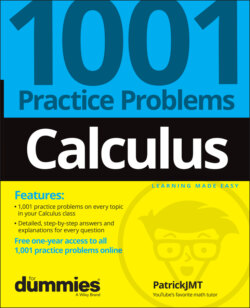Читать книгу Calculus: 1001 Practice Problems For Dummies (+ Free Online Practice) - Patrick Jones - Страница 10
ОглавлениеChapter 3
Limits and Rates of Change
Limits are the foundation of calculus. Being able to work with limits and to understand them conceptually is crucial, because key ideas and definitions in calculus make use of limits. This chapter examines a variety of limit problems and makes the intuitive idea of continuity formal by using limits. Many later problems also involve the use of limits, so although limits may go away for a while during your calculus studies, they’ll return!
The Problems You’ll Work On
In this chapter, you encounter a variety of problems involving limits:
Using graphs to find limits
Finding left-hand and right-hand limits
Determining infinite limits and limits at infinity
Practicing many algebraic techniques to evaluate limits of the form 0/0
Determining where a function is continuous
What to Watch Out For
You can use a variety of techniques to evaluate limits, and you want to be familiar with them all! Remember the following tips:
When substituting in the limiting value, a value of zero in the denominator of a fraction doesn't automatically mean that the limit does not exist! For example, if the function has a removable discontinuity, the limit still exists!
Be careful with signs, as you may have to include a negative when evaluating limits at infinity involving radicals (especially when the variable approaches negative infinity). It’s easy to make a limit positive when it should have been negative!
Know and understand the definition of continuity, which says the following: A function f(x) is continuous at a if .
Finding Limits from Graphs
167–172 Use the graph to find the indicated limit.
167.
168.
169.
170.
171.
172.
Evaluating Limits
173–192 Evaluate the given limit.
173.
174.
175.
176.
177.
178.
179.
180.
181.
182.
183.
184.
185.
186.
187.
188.
189.
190.
191.
192.
Applying the Squeeze Theorem
193–198 Use the squeeze theorem to evaluate the given limit.
193. If for all x in , find .
194. If for , find .
195. If for , evaluate .
196. Find the limit: .
197. Find the limit: .
198. Find the limit: .
Evaluating Trigonometric Limits
199–206 Evaluate the given trigonometric limit. Recall that and that .
199.
200.
201.
202.
203.
204.
205.
206.
Infinite Limits
207–211 Find the indicated limit using the given graph.
207.
208.
209.
210.
211.
212−231 Find the indicated limit.
212.
213.
214.
215.
216.
217.
218.
219.
220.
221.
222.
223.
224.
225.
226.
227.
228.
229.
230.
231.
Limits from Graphs
232–235 Find the indicated limit using the given graph.
232.
233.
234.
235.
Limits at Infinity
236–247 Find the indicated limit.
236.
237.
238.
239.
240.
241.
242.
243.
244.
245.
246.
247.
Horizontal Asymptotes
248–251 Find any horizontal asymptotes of the given function.
248.
249.
250.
251.
Classifying Discontinuities
252–255 Use the graph to find all discontinuities and classify each one as a jump discontinuity, a removable discontinuity, or an infinite discontinuity.
252.
253.
254.
255.
Continuity and Discontinuities
256–261 Determine whether the function is continuous at the given value of a. If it’s continuous, state the value at f(a). If it isn’t continuous, classify the discontinuity as a jump, removable, or infinite discontinuity.
256.
where
257.
where
258.
where
259.
where
260.
where
261.
where
262–265 Determine whether the function is continuous at the given values of a. If it isn’t continuous, classify each discontinuity as a jump, removable, or infinite discontinuity.
262.
where and
263.
where and
264.
where and
265.
where and
Making a Function Continuous
266–267 Determine the value of c that makes the given function continuous everywhere.
266.
267.
The Intermediate Value Theorem
268–271 Determine which of the given intervals is guaranteed to contain a root of the function by the intermediate value theorem.
268. By checking only the endpoints of each interval, determine which interval contains a root of the function by the intermediate value theorem:
(A)
(B)
(C)
(D)
(E)
269. By checking only the endpoints of each interval, determine which interval contains a root of the function by the intermediate value theorem:
(A)
(B)
(C)
(D)
(E)
270. By checking only the endpoints of each interval, determine which interval contains a solution to the equation according to the intermediate value theorem:
(A)
(B)
(C)
(D)
(E)
271. By checking only the endpoints of each interval, determine which interval contains a solution to the equation according to the intermediate value theorem:
(A)
(B)
(C)
(D)
(E)
